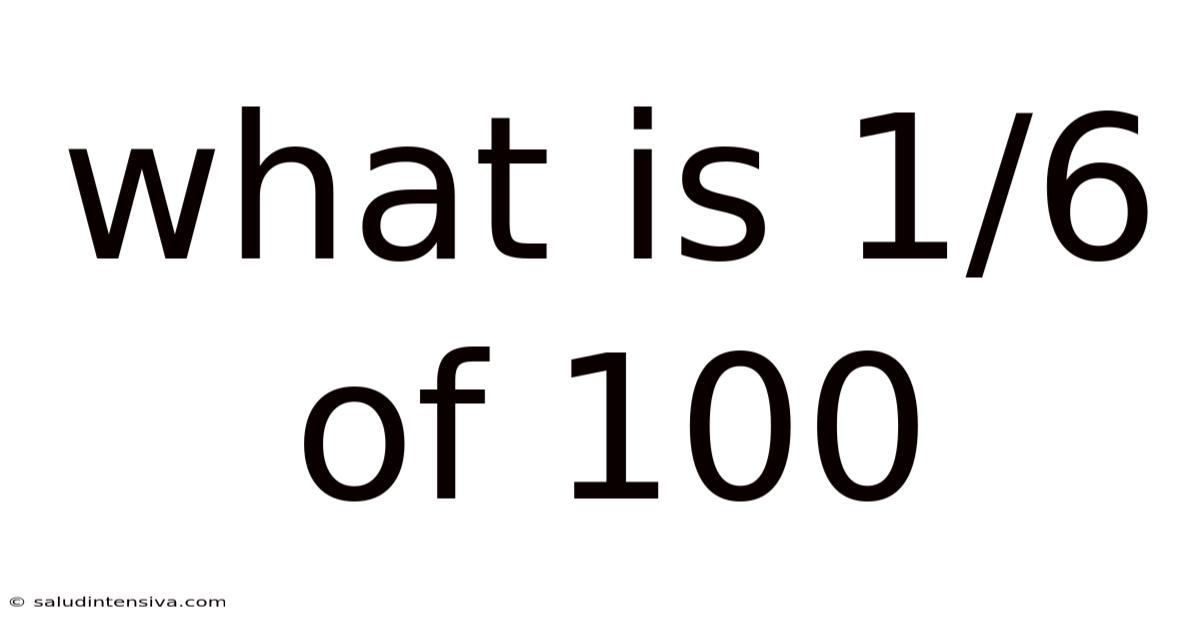What Is 1/6 Of 100
saludintensiva
Sep 25, 2025 · 5 min read

Table of Contents
What is 1/6 of 100? A Comprehensive Guide to Fractions and Division
Finding 1/6 of 100 might seem like a simple arithmetic problem, but it opens the door to understanding fundamental concepts in mathematics, particularly fractions and division. This comprehensive guide will not only solve this problem but will also delve deeper into the underlying principles, providing you with a robust understanding that extends far beyond this single calculation. We'll explore various methods for solving this, discuss the importance of fractions in everyday life, and even touch upon related mathematical concepts.
Introduction: Understanding Fractions and Division
Before tackling the problem of finding 1/6 of 100, let's refresh our understanding of fractions and division. A fraction represents a part of a whole. It's expressed as a ratio of two numbers: the numerator (top number) and the denominator (bottom number). The denominator indicates the total number of equal parts the whole is divided into, while the numerator shows how many of those parts we're considering.
Division, on the other hand, is the process of splitting a number into equal parts. Finding a fraction of a number is essentially a division problem. For example, finding 1/6 of 100 means dividing 100 into 6 equal parts and then taking one of those parts.
Method 1: Direct Division
The most straightforward method to find 1/6 of 100 is through direct division. We simply divide 100 by 6:
100 ÷ 6 = 16.666...
This gives us a repeating decimal. In many practical situations, rounding is necessary. Rounding to two decimal places, we get 16.67. Therefore, 1/6 of 100 is approximately 16.67. However, it's important to remember that this is an approximation; the true value is a recurring decimal.
Method 2: Converting to a Decimal First
Another approach is to convert the fraction 1/6 into a decimal first and then multiply by 100.
To convert 1/6 to a decimal, we perform the division:
1 ÷ 6 = 0.1666...
Now, we multiply this decimal by 100:
0.1666... × 100 = 16.666...
This yields the same result as Method 1. Again, rounding may be necessary depending on the context.
Method 3: Using Equivalent Fractions
While less efficient for this specific problem, understanding equivalent fractions is crucial for working with more complex fraction calculations. Equivalent fractions represent the same proportion but have different numerators and denominators. We can sometimes simplify calculations by finding an equivalent fraction with a denominator that divides easily into 100. Unfortunately, there's no easy equivalent fraction for 1/6 with a denominator that's a simple factor of 100.
Method 4: Visual Representation
Visualizing the problem can be helpful, especially for beginners. Imagine a circle divided into six equal slices. The whole circle represents 100. Each slice represents one-sixth of the whole. To find the value of one slice (1/6 of 100), we divide the circle (100) into six equal parts. Each part will be approximately 16.67.
The Importance of Fractions in Everyday Life
Fractions are not just abstract mathematical concepts; they are integral to our daily lives. Here are a few examples:
- Cooking and Baking: Recipes often require fractional measurements (e.g., 1/2 cup of flour, 1/4 teaspoon of salt).
- Shopping: Sales and discounts are frequently expressed as fractions (e.g., 1/3 off, 2/5 discount).
- Time: Telling time involves fractions of an hour (e.g., half past three, quarter to five).
- Measurement: Many measurement systems use fractions (e.g., inches, feet).
- Finance: Understanding fractions is essential for managing finances, calculating interest rates, and understanding shares.
Expanding on the Concept: Percentages and Ratios
This problem naturally extends to understanding percentages and ratios. A percentage is a fraction expressed as a part of 100. We can easily convert 1/6 into a percentage:
1/6 × 100% ≈ 16.67%
This means that 1/6 of 100 is 16.67%.
Ratios compare the relative sizes of two or more values. In this context, the ratio of one part to the whole (1:6) is equivalent to the fraction 1/6.
Frequently Asked Questions (FAQ)
- Q: Is 16.67 the exact answer? A: No, 16.67 is an approximation. The exact answer is the recurring decimal 16.666...
- Q: How can I calculate 1/6 of any number? A: Divide the number by 6.
- Q: What if I need a more precise answer than 16.67? A: You can express the answer as a fraction (100/6, which simplifies to 50/3) or use more decimal places in your approximation.
- Q: Why is 1/6 a recurring decimal? A: Because the denominator (6) contains prime factors other than 2 and 5, which are the only prime factors allowed for terminating decimals.
Conclusion: Mastering Fractions and Beyond
Finding 1/6 of 100 is a simple calculation that demonstrates the importance of understanding fractions and division. This seemingly straightforward problem provides a stepping stone to grasp more advanced mathematical concepts like percentages, ratios, and decimal approximations. Mastering these foundational elements is crucial for success in various academic and professional fields. Remember that practice is key to improving your understanding and efficiency in solving such problems. By approaching mathematics with curiosity and a willingness to explore different methods, you will build a strong mathematical foundation that will serve you well throughout your life. The journey of learning is continuous, and every problem solved brings you closer to a deeper understanding of the world around us.
Latest Posts
Latest Posts
-
29 4 As A Mixed Number
Sep 25, 2025
-
5 9 And 5 11 Height Difference
Sep 25, 2025
-
Words That Start With Pseudo
Sep 25, 2025
-
10to The Power Of 100
Sep 25, 2025
-
Slope 1 Y Intercept 2
Sep 25, 2025
Related Post
Thank you for visiting our website which covers about What Is 1/6 Of 100 . We hope the information provided has been useful to you. Feel free to contact us if you have any questions or need further assistance. See you next time and don't miss to bookmark.